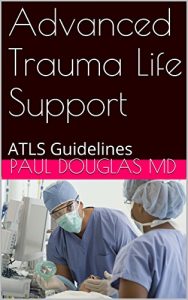Trauma is a major cause of death in the United States and in the world. Many people from all ages, gender, socioeconomic status, ethnicities and religions will suffer from trauma sometime in their lifetimes. There is a need for healthcare workers to quickly evaluate patients who present to them as trauma victims and to prioritize their treatments.
Chapter 1 is for all healthcare professionals.
Chapter 2 is tailored for surgeons in training.
Chapter 3 is a step-by-step guide to emergency procedures
TABLE OF CONTENTS
Chapter 1: Trauma Evaluation
- Primary survey
- Airway
- Breathing
- Circulation
- Disability
- Exposure and Environmental control
- Primary survey multiple choice questions
- Secondary survey
Chapter 2: Topics for surgeons in training
- Abdominal Compartment Syndrome
- Abdominal trauma
- Aortic injury
- Bladder injuries
- Burns
- Cardiac Contusion
- Cardiac tamponade (Pericardial tamponade)
- Chest trauma
- Compartment Syndrome
- Cricothyroidotomy
- CT Scan Indication
- Diaphragmatic injuries
- Diagnostic peritoneal lavage (DPL)
- Duodenal Hematoma
- Emergency Department Thoracotomy (EDT)
- Esophageal perforation
- Exploratory laparotomy indications
- Facial trauma
- Femur Fractures
- Flail chest
- Falls
- Focused Assessment with Sonography in Trauma (FAST exam)
- Glasgow Coma Scale (GCS)
- Head trauma
- Head trauma and ICP monitoring
- Hemothorax
- Hypotension
- Intubation
- Liver injuries
- Neck injury
- Hemorrhagic shock
- Liver Trauma, Liver Injury, Liver Lacerations
- Pelvic Fracture
- Pneumothorax
- Posterior knee dislocations
- Pulmonary contusion
- Rib fractures
- Scalp laceration
- Spinal injuries (Cervical spine injuries)(Spinal fractures)
- Splenic Trauma
- Transfusions
- Ureteral injuries
- Vascular injuries
Chapter 1 is for all healthcare professionals.
Chapter 2 is tailored for surgeons in training.
Chapter 3 is a step-by-step guide to emergency procedures
TABLE OF CONTENTS
Chapter 1: Trauma Evaluation
- Primary survey
- Airway
- Breathing
- Circulation
- Disability
- Exposure and Environmental control
- Primary survey multiple choice questions
- Secondary survey
Chapter 2: Topics for surgeons in training
- Abdominal Compartment Syndrome
- Abdominal trauma
- Aortic injury
- Bladder injuries
- Burns
- Cardiac Contusion
- Cardiac tamponade (Pericardial tamponade)
- Chest trauma
- Compartment Syndrome
- Cricothyroidotomy
- CT Scan Indication
- Diaphragmatic injuries
- Diagnostic peritoneal lavage (DPL)
- Duodenal Hematoma
- Emergency Department Thoracotomy (EDT)
- Esophageal perforation
- Exploratory laparotomy indications
- Facial trauma
- Femur Fractures
- Flail chest
- Falls
- Focused Assessment with Sonography in Trauma (FAST exam)
- Glasgow Coma Scale (GCS)
- Head trauma
- Head trauma and ICP monitoring
- Hemothorax
- Hypotension
- Intubation
- Liver injuries
- Neck injury
- Hemorrhagic shock
- Liver Trauma, Liver Injury, Liver Lacerations
- Pelvic Fracture
- Pneumothorax
- Posterior knee dislocations
- Pulmonary contusion
- Rib fractures
- Scalp laceration
- Spinal injuries (Cervical spine injuries)(Spinal fractures)
- Splenic Trauma
- Transfusions
- Ureteral injuries
- Vascular injuries












